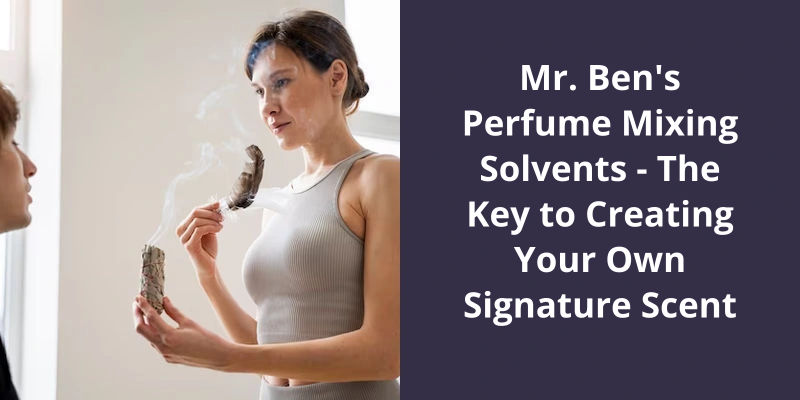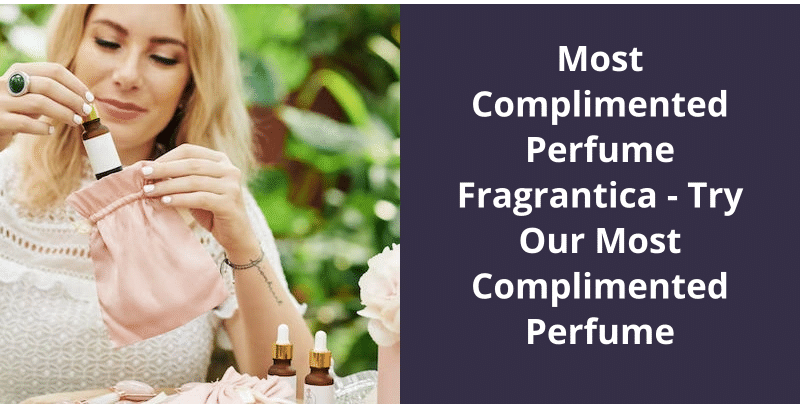Mr. Ben’s Perfume Mixing Solvents are the essential elements that help you create your very own custom scent. These solutions work by dissolving the raw ingredients of your perfume, ensuring that you get a smooth blend. Apart from this, they also help to dilute stronger ingredients to balance the overall smell. Using Mr. Ben’s Mixing Solvents, you can turn the entire process of perfume making into a simple and enjoyable activity. They’re specifically designed to hold and carry the fragrance, ensuring that your signature scent lasts as long as possible. In essence, they’re the secret to producing a beautiful, long-lasting perfume that reflects your personal style and preference.

What Is the Solvent of Perfume?
These notes can be classified into three major categories. The top note, middle note, and base note. The top note gives the first impression of the perfume scent and will evaporate quickly. The base note is the longest-lasting note and it gives the perfume it’s depth and richness, holding the scent together.
Ethanol is a popular solvent because it’s a colorless, flammable liquid that’s readily available and easily evaporates. It also helps to enhance the scent of the perfume by evaporating quickly, leaving behind only the scent notes. However, too much ethanol can overpower the scent notes, so water is often added to dilute the alcohol and balance the scent. Water also helps the scent to evaporate more slowly, which makes it last longer on the skin.
There are other solvents that can be used in perfumes, like propylene glycol, which is often used in cosmetic products such as lotions and creams. It’s also odorless and colorless, therefore doesn’t interfere with the scent notes. However, it’s a thick consistency that can make perfumes feel heavier on the skin.
The quality of the solvent used can also affect the quality of the perfume. For example, the purity of the ethanol used should be at least 95%, as impurities can alter the scent and damage the scent notes. Additionally, the ethanol used should be denatured to prevent it from being consumed as an alcoholic beverage, as this is illegal in most countries.
The Art of Perfumery and How Scents Are Created and Combined
Perfumery refers to the art of creating fragrances by combining various scents. The process is done by combining natural and synthetic ingredients to make a unique and pleasant aroma. This art involves deep understanding of fragrances, their origins, combinations, and how they interact with each other. The final product is a complex blend of scents that reflect the vision and skill of the perfumer.
Thanks to the continuous advancements in technology, the fragrance industry is witnessing constant innovation in the way perfumes are made. One such development is the manufacturing of non-alcoholic perfumes. Using a water-based nanoemulsion, these perfumes are created without the use of ethanol or other solvents, making them safer and more widely accessible to consumers. In this article, we will delve deeper into the process of making non-alcoholic perfumes, along with their benefits and potential drawbacks.
How Are Non Alcoholic Perfumes Made?
Non-alcoholic perfumes have become increasingly popular in recent years, and the development of these fragrances has been a game-changer in the beauty industry. Rather than relying on the traditional method of using alcohol as a base, non-alcoholic perfumes are created using a water-based nanoemulsion. This innovative process allows for the removal of ethanol and other solvents, making them safer for everyday use.
One of the primary benefits of non-alcoholic perfumes is their potential to reach a far wider audience than traditional perfumes. With the elimination of alcohol, this type of fragrance is safe for those with sensitive skin or allergies to certain chemicals commonly found in perfumes. Additionally, the lack of flammable solvents makes them much safer to use and store.
This is achieved by combining essential oils with carefully chosen surfactants and emulsifiers that help to create a stable and homogeneous mixture. Once the emulsion has been created, it’s then blended with other natural ingredients to create the final fragrance.
This is due to the fact that the water-based emulsion allows the fragrance to be released gradually over time, rather than evaporating quickly as with an alcohol-based perfume.
Differences Between Alcohol-Based and Non-Alcoholic Perfumes
- Alcohol-based perfumes contain ethanol as a solvent, while non-alcoholic perfumes use oil or water as a carrier.
- Alcohol-based perfumes evaporate faster than non-alcoholic perfumes.
- Non-alcoholic perfumes are generally considered to be milder on the skin compared to alcohol-based perfumes.
- Alcohol-based perfumes tend to have a stronger and longer-lasting scent than non-alcoholic perfumes.
- Alcohol-based perfumes may cause irritation or allergic reactions on sensitive skin, while non-alcoholic perfumes are generally considered to be safer.
- Non-alcoholic perfumes are more environmentally friendly than alcohol-based perfumes, as ethanol is derived from fossil fuels and contributes to air pollution.
Perfume-making is an artform that involves a variety of methods and ingredients to achieve the desired scent. Among these components, the solvent used to carry the fragrance concentrate is crucial. This article will delve into the most common solvent used in perfumery, it’s unique properties and it’s significance to the art of fragrance creation.
What Is the Most Common Solvent in Perfumery?
It’s been used for generations in the fragrance industry as a reliable solvent for various fragrance ingredients that make up the final scent. Perfumers Alcohol is a highly refined formula that’s been specifically produced to enhance and protect the fragrance concentrate, while also providing a sustainable and safe carrier medium for the scent oils.
This solvent is derived from natural sources such as sugarcane, and it’s a clear and colorless liquid that’s no scent or taste. It’s made up of 95% ethanol that’s been specially denatured with a small amount of essential oil to make it unfit for human consumption.
It’s a low boiling point, which allows the fragrance to evaporate quickly and disperse the scent evenly. This solvent is also highly miscible with water, making it easy to dilute the fragrance concentrate to the desired strength.
It also provides a long-lasting scent, which is why it’s commonly used in commercial fragrances. Additionally, this solvent is known for it’s gentle and non-irritating properties, making it an ideal choice for sensitive skin.
How Perfumers Alcohol Is Produced and Refined
- Perfumers alcohol is usually made up of a blend of ethanol and water.
- The ethanol used should be 96% pure and the water should be distilled.
- Blends may vary, with some perfumers preferring a higher percentage of ethanol for certain fragrances.
- Production and refining usually involves multiple distillations and filtrations to remove impurities and ensure consistency.
- The final product should be colorless, odorless, and tasteless.
Source: Fragrance extraction
Now, to make your own perfume, you need to know how to mix perfume oil with solvent. The ideal ratio is 20% perfume oil and 80% solvent, but since fragrance oils are typically quoted by weight and solvents are purchased by volume, some calculations are needed to achieve the desired outcome. Let’s take a closer look at the steps involved in mixing perfume oil with solvent.
How Do You Mix Perfume Oil With Solvent?
Mixing perfume oil with solvent is an art in itself. The process involves blending the oil into the solvent in a precise manner to achieve the desired scent. The ratio of oil to solvent is an essential factor in perfume-making. The most common proportion is 20% oil and 80% solvent, but it can vary depending on the type of fragrance you want to create. For instance, if you want a more potent scent, you can increase the concentration of oil up to 30%.
To make a 20% oil solution, youll need 200 ml of perfume oil and 800 ml of the solvent. The solvent can be alcohol or a carrier oil. Alcohol is the ideal solvent as it evaporates quickly, leaving behind the scent, while carrier oils such as jojoba, almond, or olive oils provide a more extended duration of scent. When choosing your solvent, you must consider the type of scent you want to create, your budget, and the level of skin tolerance the mixture should have.
Since fragrance oils are typically sold by weight, while solvents are purchased by volume, you need to convert the oils weight to volume. To do this, youll need to know the oils specific gravity which measures it’s density compared to water. Specific Gravities of oils range from 0.80 to 1.29 depending on the type of oil. Once you know the specific gravity, you can use a conversion formula to convert the oils weight to volume.
Once youve blended the oil and solvent, it’s essential to let the mixture rest for 24 hours to allow the oils and solvents to fuse properly. The mixture should be kept in a cool, dark place throughout the resting period. After this, you can test the scent and make the necessary adjustments. If you want a less potent scent, you can add more solvent.
Tips for Choosing the Right Fragrance Oils for Perfume-Making
When selecting fragrance oils for perfume-making, consider your desired scent profile and the intended use of your perfume. Choose oils that complement one another and that are appropriate for your skin type. Start with a small amount and experiment until you find the perfect blend. Always purchase high-quality fragrance oils from reputable suppliers.
Now that we understand how alcohol is used in the production of perfume, we can explore whether alcohol has the ability to dissolve perfume after it’s already been created.
Can Alcohol Dissolve Perfume?
This is why alcohol is commonly used in perfumes to dissolve essential oils, fragrant compounds, and fixatives. Fixed oils or essential oils that aren’t soluble in water can be dissolved in ethanol, thereby increasing the diffusion and volatility of the fragrance.
There are, however, some limitations to using alcohol as a solvent for perfume. For instance, high-proof alcohols may disturb the fragrances balance, causing some components to evaporate faster than others.
Another important factor is the quality of the alcohol used. The purity of the alcohol affects the stability of the fragrance, as well as it’s color and clarity. In some cases, impurities in the alcohol might cause the perfume to darken or change color over time. For this reason, high-quality perfumers insist on using a neutral alcohol that’s free from impurities and without any unwanted fragrance.
A Comparison Between Alcohol-Based and Oil-Based Perfumes, Including the Pros and Cons of Each.
- Alcohol-based perfumes:
- Pros:
- Evaporates quickly, leaving a refreshing scent
- Long-lasting fragrance
- Easy availability
- Cons:
- Can cause dryness or irritation on sensitive skin
- Strong odor can be overwhelming for some
- Can stain clothes or jewelry
- Pros:
- Oil-based perfumes:
- Pros:
- Gentle on skin, suitable for sensitive skin
- Long-lasting fragrance
- No stain on clothes or jewelry
- Cons:
- Takes longer to absorb and may feel greasy
- May not have a refreshing scent
- Not easily available
- Pros:
Conclusion
His meticulous experimentation with various solvents and ingredients demonstrates his unwavering commitment to achieving the perfect balance in each fragrance, and his willingness to take creative risks sets him apart as a true artist in the world of perfumery.





